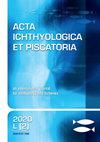利用耳石进行鱼类种群识别:现状与挑战
IF 0.8
4区 农林科学
Q3 FISHERIES
引用次数: 12
摘要
耳石是钙化的结构,其化学或形状所包含的信息可以用来推断生命史事件、迁徙模式和鱼群结构。了解耳石化学如何受到温度、盐度、非生物因素、个体发育、生理等的相互作用的影响,对于重建影响鱼类的环境至关重要。耳石的形状除了受基因型影响外,还受环境条件的影响。近年来,由于分析方法和相关软件的进步,耳石化学和形状在种群鉴别中的应用越来越多。种群识别方法有时会产生不同的结果,但如果我们采用互补的方法,所产生的信息将更加可靠,可用于制定有效的管理和保护策略。对于影响耳石化学和形状的因素,特别是当两个或多个因素协同作用时,似乎有必要获得更多的信息。因此,本文的目的是提供影响耳石化学和形状的各种因素的综合信息,以及耳石化学和形状在鱼类种群识别中的应用,并强调需要进一步研究的领域。本文章由计算机程序翻译,如有差异,请以英文原文为准。
Using otoliths for fish stock discrimination: status and challenges
Otoliths are calcified structures and the information contained within their chemistry or shape can be used to infer life history events, migration patterns, and stock structure of a fish population. Understanding how otolith chemistry is affected by temperature, salinity, interactive effects of abiotic factors, ontogeny, physiology, etc. is essential for the reconstruction of the environment that affected the fish. Otolith shape is also affected by environmental conditions in addition to the genotype. The applications of otolith chemistry and shape for stock discrimination have increased in recent years because of the advancements in analytical methods and the related software. The stock identification methods sometimes provide variable results but if we use complementary approach the information generated could be more reliable which can be used to prepare effective management and conservation strategies. It appears warranted to generate more information on the factors influencing otolith chemistry and shape especially when two or more factors exert synergetic influence. Therefore, the objectives of this review paper were to provide comprehensive information on various factors influencing the otolith chemistry and shape, and the utility of otolith chemistry and shape for fish stock discrimination with an emphasis towards the research areas needing additional studies.
求助全文
通过发布文献求助,成功后即可免费获取论文全文。
去求助
来源期刊

Acta Ichthyologica Et Piscatoria
FISHERIES-ZOOLOGY
CiteScore
2.20
自引率
0.00%
发文量
31
审稿时长
>12 weeks
期刊介绍:
ACTA ICHTHYOLOGICA ET PISCATORIA (AIeP) is an international, peer-reviewed scientific journal that publishes articles based on original experimental data or experimental methods, or new analyses of already existing data, in any aspect of ichthyology and fisheries (fin-fish only).
 求助内容:
求助内容: 应助结果提醒方式:
应助结果提醒方式:


